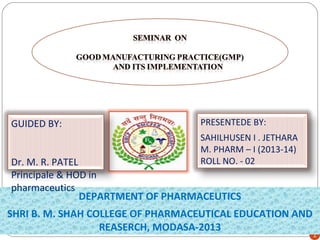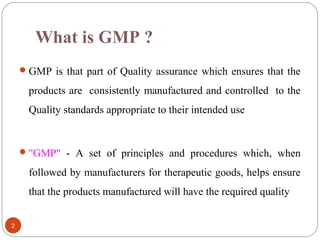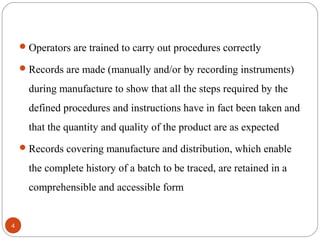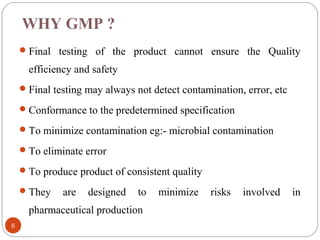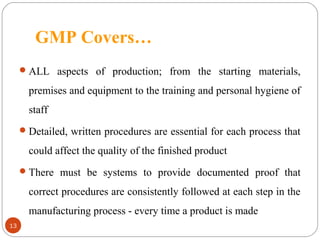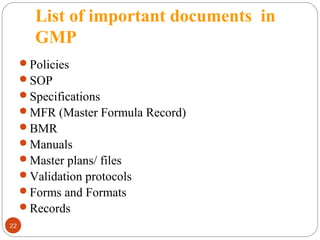Gmp & its implementation sahil
- 1. GUIDED BY: PRESENTEDE BY: SAHILHUSEN I . JETHARA M. PHARM ŌĆō I (2013-14) ROLL NO. - 02 Dr. M. R. PATEL Principale & HOD in pharmaceutics DEPARTMENT OF PHARMACEUTICS SHRI B. M. SHAH COLLEGE OF PHARMACEUTICAL EDUCATION AND REASERCH, MODASA-2013 1
- 2. What is GMP ? ’éŚ GMP is that part of Quality assurance which ensures that the products are consistently manufactured and controlled to the Quality standards appropriate to their intended use ’éŚ "GMP" - A set of principles and procedures which, when followed by manufacturers for therapeutic goods, helps ensure that the products manufactured will have the required quality 2
- 3. GMP Includes ’éŚ All manufacturing processes are clearly defined, systematically reviewed in the light of experience, and shown to be capable of consistently manufacturing pharmaceutical products of the required quality that comply with their specifications ’éŚ Qualification and validation are performed ’éŚ All necessary resources are provided ’éŚ Instructions and procedures are written in clear and unambiguous language, specifically applicable to the facilities provided 3
- 4. ’éŚ Operators are trained to carry out procedures correctly ’éŚ Records are made (manually and/or by recording instruments) during manufacture to show that all the steps required by the defined procedures and instructions have in fact been taken and that the quantity and quality of the product are as expected ’éŚ Records covering manufacture and distribution, which enable the complete history of a batch to be traced, are retained in a comprehensible and accessible form 4
- 5. ’éŚ The proper storage and distribution of the products minimizes any risk to their quality ’éŚ A system is available to recall any batch of product from sale or supply ’éŚ Complaints about marketed products are examined, the causes of quality defects investigated, and appropriate measures taken in respect of the defective products to prevent recurrence 5
- 6. WHY GMP ? ’éŚ Final testing of the product cannot ensure the Quality efficiency and safety ’éŚ Final testing may always not detect contamination, error, etc ’éŚ Conformance to the predetermined specification ’éŚ To minimize contamination eg:- microbial contamination ’éŚ To eliminate error ’éŚ To produce product of consistent quality ’éŚ They are designed to pharmaceutical production 6 minimize risks involved in
- 7. What is cGMP ? ’éŚUsually see ŌĆ£cGMPŌĆØ ŌĆō where c = current, to emphasize that the expectations are dynamic 7
- 8. 8
- 9. Good Manufacturing Practices ’éŚA basic tenet of GMP is that quality cannot be tested into a batch of product but must be built into each batch of product during all stages of the manufacturing process ’éŚIt is designed to minimize the risks involved in any pharmaceutical production that cannot eliminated through testing the final product 9 be
- 10. Some of the main risks are ’éŚunexpected contamination of products, causing damage to health or even death ’éŚincorrect labels on containers, which could mean that patients receive the wrong medicine ’éŚinsufficient or too much active ingredient, resulting in ineffective treatment or adverse effects 10
- 11. Why GMP is important ’éŚA poor quality medicine may contain toxic substances that have been unintentionally added ’éŚA medicine that contains little or none of the claimed ingredient will not have the intended therapeutic effect 11
- 12. GMP helps Boost Pharmaceutical Export Opportunities ’éŚ Most countries will only accept import and sale of medicines that have been manufactured to internationally recognized GMP ’éŚ Governments seeking to promote their countries export of pharmaceuticals can do so by making GMP mandatory for all pharmaceutical production and by training their inspectors in GMP requirements 12
- 13. GMP CoversŌĆ” ’éŚ ALL aspects of production; from the starting materials, premises and equipment to the training and personal hygiene of staff ’éŚ Detailed, written procedures are essential for each process that could affect the quality of the finished product ’éŚ There must be systems to provide documented proof that correct procedures are consistently followed at each step in the manufacturing process - every time a product is made 13
- 14. QA, GMP & QC inter-relationship ’éŚQA: It is the sum total of the organized arrangements with the objective of ensuring that products will be of the quality required for their intended use 14
- 15. ’éŚ GMP: Is that part of Quality Assurance aimed at ensuring that products are consistently manufactured to a quality appropriate to their intended use ’éŚ QC: Is that part of GMP concerned with sampling, specification & testing, documentation & release procedures which ensure that the necessary & relevant tests are performed & the product is released for use only after ascertaining itŌĆÖs quality 15
- 16. GMP Guidelines ’éŚ GMP as per Schedule ŌĆ£MŌĆØ www.cdsco.nic.in ’éŚ GMP as per WHO www.who.int ’éŚ GMP as per MCA now known as MHRA www.mca.gov.uk ’éŚ GMP as per TGA www.tga.gov.au ’éŚ GMP as per US FDA www.fda.gov ’éŚ GMP as per ICH guidelines www.ich.org 16
- 17. GMP ’éŚGMP in solid dosage forms ’éŚGMP in semisolid dosage forms ’éŚGMP in Liquid orals ’éŚGMP in Parenterals Production ’éŚGMP in Ayurvedic medicines ’éŚGMP in Bio technological products ’éŚGMP in Nutraceuticals and cosmeceuticals ’éŚGMP in Homeopathic medicines 17
- 18. GMP ’éŚGood Manufacturing Practice ’éŚGood Management Practice ’éŚGet More Profit ’éŚGive more Production ’éŚGMP Training with out tears 18
- 19. Ten Principles of GMP 1. 2. Follow written procedures and Instructions 3. Document work 4. Validate work 5. Monitor facilities and equipment 6. Write step by step operating procedures and work on instructions 7. Design ,develop and demonstrate job competence 8. Protect against contamination 9. Control components and product related processes 10. 19 Design and construct the facilities and equipments properly Conduct planned and periodic audits
- 20. Beyond GMP ’éŚReduce pollution -’āĀ Zero discharge ’éŚAdaptation of environment friendly methods ’éŚConsideration for better and healthier life tomorrow ’éŚConsideration of ethics in life ’éŚOne should begin with end in mind otherwise it will be the beginning of the end 20
- 21. Cost of effective GMP ’éŚIn fact Cost benefits ŌĆō positive cost benefits of GMP/QA ’éŚGood plant lay out, Smooth work flows, Efficient documentation systems, well controlled process, good stores lay outs and stores records- These are Good manufacturing practices ’éŚReduction in work in process and inventory holding costs ’éŚAvoidance of cost of Quality failure ( cost of waste, of rework, of recall, of consumer compensation and of loss of company reputation) 21
- 22. List of important documents in GMP ’éŚPolicies ’éŚSOP ’éŚSpecifications ’éŚMFR (Master Formula Record) ’éŚBMR ’éŚManuals ’éŚMaster plans/ files ’éŚValidation protocols ’éŚForms and Formats ’éŚRecords 22
- 23. 10 attributes of a good document Accurate 2. Clear 3. Complete 4. Consistent 5. Indelible 6. Legible 7. Timely 8. Direct 9. Authentic 10. Authorized 1. 23
- 24. Certifying agencies ’éŚICH. www.ich.org ’éŚWHO. www.who.int ’éŚUS FDA. www.fda.gov ’éŚEU/EMEA. www.emea.europa.eu 24
- 25. How do GMPs of different countries compare? At a high level, GMPs of various nations are very similar, most require things like: ’āś Equipment and facilities being properly designed, maintained, and cleaned ’āś Standard Operating Procedures (SOPs) be written and approved ’āś An independent Quality unit (like Quality Control and/or Quality Assurance) ’āś Well trained personnel and management 25
- 26. cGMP For Finished Pharmaceuticals General Provision Organization & Personnel Building & Facilities Equipment Control of Components & Drug Product Containers & Closures 6. Production & Process Control 7. Packaging & Labeling Control 8. Handling & Distribution 9. Laboratory Control 10. Records & Reports 11. Returned & Salvaged Drugs 1. 2. 3. 4. 5. 26
- 27. Organization & Personnel 1. 2. Personnel qualifications 3. Personnel responsibilities 4. 27 Responsibilities of quality control unit Consultants
- 28. Building & Facilities 1. 2. Lighting 3. Ventilation, air filtration, air heating and cooling 4. Plumbing 5. Sewage and refuse 6. Washing and toilet facilities 7. Sanitation 8. 28 Design and construction features Maintenance
- 29. Equipment 1. 2. Equipment construction 3. Equipment cleaning and maintenance 4. Automatic, mechanical, and electronic equipment 5. 29 Equipment design, size, and location Filters
- 30. Control of Components & Drug Product Containers & Closures 1. 2. 3. 4. 5. 6. 7. 30 General requirements. Receipt & storage of untested components, drug product containers, and closures Testing and approval or rejection of components, drug product containers, and closures Use of approved components, drug product containers, and closures Retesting of approved components, drug product containers, and closures Rejected components, drug product containers, and closures. Drug product containers and closures.
- 31. Production & Process Control 1. 2. 3. 4. 5. 6. 7. 8. 31 Written procedures; deviations Charge-in of components Calculation of yield Equipment identification Sampling and testing of in-process materials and drug products Time limitations on production Control of microbiological contamination Reprocessing
- 32. Packaging & Labeling Control 1. 2. 3. 4. 5. 6. 32 Materials examination and usage criteria Labeling issuance Packaging and labeling operations Tamper-evident packaging requirements for overthe-counter (OTC) human drug products Drug product inspection Expiration dating
- 33. Handling & Distribution 1. 2. 33 Warehousing procedures Distribution procedures
- 34. Laboratory Control 1. 2. Testing and release for distribution 3. Stability testing 4. Special testing requirements 5. Reserve samples 6. Laboratory animals 7. 34 General requirements Penicillin contamination
- 35. Records & Reports 1. 2. 3. 4. 5. 6. 7. 8. 9. 35 General requirements Equipment cleaning and use log Component, drug product container, closure, and labeling records Master production and control records Batch production and control records Production record review Laboratory records Distribution records Complaint files
- 36. Returned & Salvaged Drug Products 1. 2. 36 Returned drug products Drug product salvaging
- 37. Ph. No. :- +918460378336 Address:- 44, Assiyana Society; Dugarvada Road, Taluko & City : Modasa State: Gujarat Country: India Email: sahil.pharm4@gmail.com 37 BEST OF LUCK TO ALL . . . . . . . . . .
